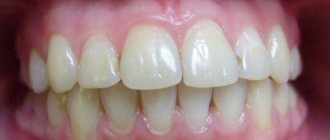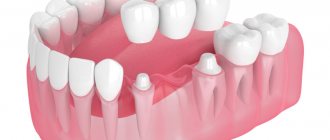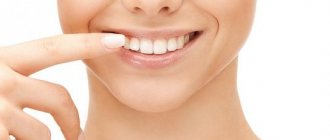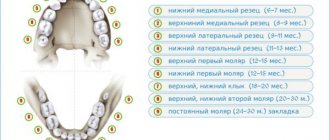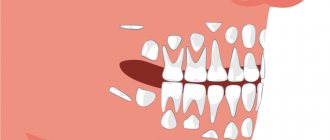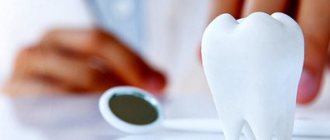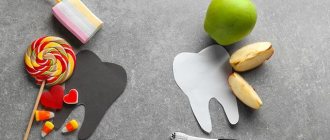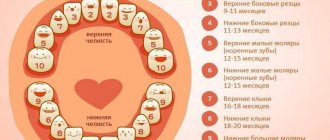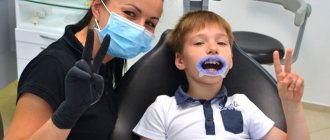Anomalies and pathologies of the oral cavity, especially the dentition, are a phenomenon that every person inevitably encounters in one way or another. Caries, gum disease, toothache - any disease requires the help of a specialist, since it interferes with normal daily activities. The vast majority of pathologies are the result of improper care of teeth and oral cavity - by regularly performing a set of health procedures, you can prevent diseases and save yourself from unnecessary problems.
Intact – what is it?
What is an intact tooth in dentistry? Translated from Latin, intactus means “untouched.” Accordingly, an intact one is one that is intact, healthy and not affected by any inflammatory processes or diseases. Hearing this term in relation to his teeth after a preventive examination, the patient should rejoice. You can experience twice as many positive emotions if the doctor says that you have an intact dentition, because this means that all the elements in the row are healthy.
Important! The term can be applied not only to the whole tooth, but also to its individual components and structures - enamel, crown, root, periodontal tissue. The doctor may also use a phrase such as intact surface, but this does not mean at all that the tooth is healthy - it may be affected by caries, pulpitis or periodontitis, but at the same time, areas not affected by infection or destructive processes remain.
Oral care rules
Oral cavity prevention is based on a combination of hygiene procedures and regular checks of the condition of the gums and tooth enamel by a specialist. The development of dental diseases is a long process, which is not difficult to track with periodic visits to the doctor. A quarterly examination allows you to identify deviations and possible negative factors, the elimination of which at an early stage will be much easier and cheaper for the patient.
Brushing your teeth and oral cavity is a key hygiene procedure, the purpose of which is to remove food debris and prevent the formation of plaque. Food particles stuck in hard-to-reach places become a beneficial environment for the accumulation and development of pathogenic bacteria that corrode the enamel coating of teeth, form caries and provoke inflammatory processes. Regular use of a brush and toothpaste is a common and affordable method that keeps your breath fresh, your teeth white, and prevents the most common types of diseases.
Cases in which intact surfaces have to be prepared
Installation of veneers and lumineers
Doctors always resort to preparation of hard tissues before installing prostheses. Even if you are just going to install veneers or ultraneers to hide the unsatisfactory shade of enamel and diastema, you need to be prepared for grinding. The frontal surface, even if it is completely intact, will be subjected to minor preparation. How much fabric will need to be sewn? Everything will depend on the thickness of the lining, approximately 0.3–0.8 mm.
On a note! If you decide to improve the aesthetics of the smile area with the help of artistic restorations with a composite, to hide the diastema (interdental gap), for example, then the doctor will also carry out a minor preparation of the frontal surfaces of the anterior units so that the filling materials fit better to them.
You will have to grind the enamel the least if you choose lumineers. However, the doctor will still have to lightly sand it down to a thickness equal to the thickness of the onlay (about 0.3 mm) to ensure high quality fixation and a natural smile.
Prosthetics with bridges
An intact tooth can act as a support tooth for bridge prosthetics. And before installing the structure, it will have to be very thoroughly prepared; trephination (opening) of the crown will be carried out and the pulp will be removed.
Treatment of pulpitis and periodontitis
The physician may touch an intact surface, such as the palatal surface, when treating pulpitis or periodontitis on incisors or canines in order to provide access to the coronal portion of the pulp and root canal orifices. It is not possible to do this from the front side of the cutting edge, since then there is a risk of spoiling the natural shape, aesthetics and functionality.
Bite correction
It is necessary to touch the intact surfaces of some teeth when carrying out a procedure such as separation (grinding). Most often it is used in orthodontics if the bite pathology is minor. The procedure helps to avoid removing some elements of the row. During the process, the doctor grinds off the enamel from the side surfaces and can free up up to 5 mm of space on the jaw.
Prevention measures
All various preventive measures that help keep teeth healthy can be divided into 4 groups:
- Regular visits to the doctor.
- Proper oral hygiene.
- Power control. Providing the body with nutritional components that ensure the proper development of the dentofacial apparatus. Acceptance or, on the contrary, exclusion of those products that, by their physical form, are beneficial or harmful to the condition of enamel and dentin.
- Improved overall health.
Visiting a doctor for preventive purposes
As already noted, you need to visit the dentist at least 2 times a year. The optimal frequency is considered to be once every 3 months. During a preventive examination, the doctor will definitely notice the onset of the disease and take the necessary measures.
Reasons for performing dental trepanation and the specialist’s course of action.
In this publication we will discuss the importance of photodynamic therapy in dentistry.
Here https://www.vash-dentist.ru/lechenie/zubyi/lidoksor-partner-stomatologa.html all the most important things about the drug Lidoxor.
Oral care
You need to brush your teeth at least 2 times a day: the first time in the morning after meals (you can rinse your mouth before breakfast), the second, mandatory time, in the evening after dinner. Pre-night cleaning is more important than the first, because if it is not done, food debris will remain in the oral cavity for a long time.
To clean the proximal space, you need to use brushes and floss.
You should begin and end brushing by rinsing your mouth with mouthwash or clean water.
The brush is changed once every 2-5 months , the paste - every 1.5-2 months. The bristles should not be very hard, suitable for enamel and gums, the brush head should not be traumatic. It is advisable to periodically use specialized pastes with fluoride, calcium, triclosan, whitening, and medicinal herbs.
To clean MVPs and orthodontic appliances, it is recommended to use superflosses - thinner threads of a special structure.
You also need to clean your tongue with a special scraper.
Do not use foreign objects, such as needles, for cleaning. Even toothpicks should be used carefully, without excessive zeal, so as not to damage the enamel or injure the gums.
Nutrition
Food must contain all the components necessary for the body. Too sweet and sour foods are considered harmful to enamel and dentin; it is advisable to reduce their intake.
The menu should contain not only soft, but also fairly hard foods that partially cleanse the teeth of soft plaque and create a healthy load for them. At the same time, too hard (nuts, crackers) and viscous (toffee) foods should be excluded from the diet.
General health
It has been established that there are cause-and-effect relationships between caries and certain diseases and conditions. Susceptibility to caries increases with Kashin-Beck disease, hypothyroidism, rheumatism, and changes in hormonal status.
Pregnancy is a predisposing factor to caries. Radiation therapy used in the treatment of tumors of the head and neck is very dangerous for the condition of enamel and dentin.
Heredity also influences a person's susceptibility to caries.
The exact mechanism by which general health affects dental health is not fully understood. However, it is assumed that the connection between them is determined by the pulp, which contains blood vessels that feed dentin and enamel, the composition of the oral fluid and the condition of the periodontium.
For all of the above cases, special preventive measures have been developed that reduce the risk and severity of mediated dental diseases. They should be used on the recommendation of a doctor.
Learn how to keep your teeth healthy from the video.
Orthodontic bite correction
There are often clinical cases in which, before treating malocclusions with braces or aligners, some teeth must first be removed. This is done to free up free space on the jaw. In this case, the intact tooth itself may have a normal location, but it has to be sacrificed. Often the third molars are removed, less often the second and first ones.
On a note! The definition of intact is a tooth that is not affected by dental diseases such as caries, pulpitis or periodontitis. However, it may be curved, occupy an incorrect position in the row, be supernumerary, or have signs of macrodentia (crowns that are too large in size) or microdentia (small crowns).
If the unit is intact or has an oversized crown, it will most likely have to be removed before braces can be placed.
Why remove intact milk units?
This must be done in cases where the time frame for changing milk units to permanent ones is delayed. At the age of 7–8 years, permanent teeth begin to erupt, but temporary teeth should begin to fall out, but not all children have this process smoothly.
It also happens that the dairy ones, due to excessive mineralization or due to the individual characteristics of the body, do not even wobble, although the rudiments of permanent ones are already resting on their roots.
If such elements are not removed in a timely manner, the permanent ones may make their way into the second row. This can cause crowding and malocclusion in adulthood.
Dental health
Everyone knows from childhood that there is nothing more important than your health. This is one of those things that money cannot buy. After all, they can only help a little to correct the undermined state of health. But many people take their health for granted until it is too late. This also applies to dental health.
Everyone knows that for preventive care you need to visit the dentist at least once every six months, but only a few do this. As a rule, a person does not have the desire or time for such seemingly useless trips.
What stops people from going to the doctor is usually a groundless fear of dentists. This fear is unfounded, since even the most insignificant operations are performed under anesthesia, which completely numbs the pain, even a couple of hours after the medical procedure.
Most often, a patient consults a doctor when the gums and cheeks become swollen, and the toothache becomes unbearable. And that is why many with such a negligent attitude towards their health do not know basic medical terms.
